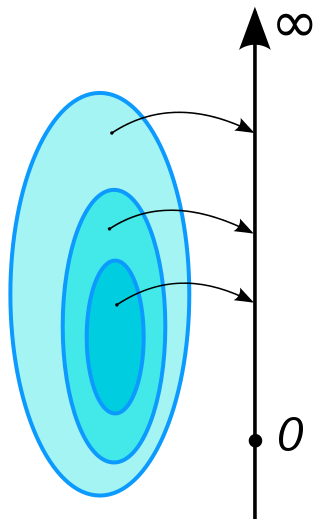Proof of theorem
Step 1. We begin by showing that  is
is  –measurable. [4] : section 21.3
–measurable. [4] : section 21.3
Note. If we were using Fatou's lemma, the measurability would follow easily from Remark 3(a).
To do this without using Fatou's lemma, it is sufficient to show that the inverse image of an interval  under
under  is an element of the sigma-algebra
is an element of the sigma-algebra  on
on  , because (closed) intervals generate the Borel sigma algebra on the reals. Since
, because (closed) intervals generate the Borel sigma algebra on the reals. Since  is a closed interval, and, for every
is a closed interval, and, for every  ,
,  ,
,

Thus,

Being the inverse image of a Borel set under a  -measurable function
-measurable function  , each set in the countable intersection is an element of
, each set in the countable intersection is an element of  . Since
. Since  -algebras are, by definition, closed under countable intersections, this shows that
-algebras are, by definition, closed under countable intersections, this shows that  is
is  -measurable, and the integral
-measurable, and the integral  is well-defined (and possibly infinite).
is well-defined (and possibly infinite).
Step 2. We will first show that 
The definition of  and monotonicity of
and monotonicity of  imply that
imply that  , for every
, for every  and every
and every  . By monotonicity (or, more precisely, its narrower version established in Remark 5; see also Remark 4) of the Lebesgue integral,
. By monotonicity (or, more precisely, its narrower version established in Remark 5; see also Remark 4) of the Lebesgue integral,

and

Note that the limit on the right exists (finite or infinite) because, due to monotonicity (see Remark 5 and Remark 4), the sequence is non-decreasing.
End of Step 2.
We now prove the reverse inequality. We seek to show that
 .
.
Proof using Fatou's lemma. Per Remark 3, the inequality we want to prove is equivalent to

But the latter follows immediately from Fatou's lemma, and the proof is complete.
Independent proof. To prove the inequality without using Fatou's lemma, we need some extra machinery. Denote by  the set of simple
the set of simple  -measurable functions
-measurable functions  such that
such that  on
on  .
.
Step 3. Given a simple function  and a real number
and a real number  , define
, define

Then  ,
,  , and
, and  .
.
Step 3a. To prove the first claim, let  , for some finite collection of pairwise disjoint measurable sets
, for some finite collection of pairwise disjoint measurable sets  such that
such that  , some (finite) non-negative constants
, some (finite) non-negative constants  , and
, and  denoting the indicator function of the set
denoting the indicator function of the set  .
.
For every 
 holds if and only if
holds if and only if  Given that the sets
Given that the sets  are pairwise disjoint,
are pairwise disjoint,

Since the pre-image  of the Borel set
of the Borel set  under the measurable function
under the measurable function  is measurable, and
is measurable, and  -algebras, by definition, are closed under finite intersection and unions, the first claim follows.
-algebras, by definition, are closed under finite intersection and unions, the first claim follows.
Step 3b. To prove the second claim, note that, for each  and every
and every  ,
, 
Step 3c. To prove the third claim, we show that  .
.
Indeed, if, to the contrary,  , then an element
, then an element

exists such that  , for every
, for every  . Taking the limit as
. Taking the limit as  , we get
, we get

But by initial assumption,  . This is a contradiction.
. This is a contradiction.
Step 4. For every simple  -measurable non-negative function
-measurable non-negative function  ,
,

To prove this, define  . By Lemma 1,
. By Lemma 1,  is a measure on
is a measure on  . By "continuity from below" (Lemma 2),
. By "continuity from below" (Lemma 2),

as required.
Step 5. We now prove that, for every  ,
,

Indeed, using the definition of  , the non-negativity of
, the non-negativity of  , and the monotonicity of the Lebesgue integral (see Remark 5 and Remark 4), we have
, and the monotonicity of the Lebesgue integral (see Remark 5 and Remark 4), we have

for every  . In accordance with Step 4, as
. In accordance with Step 4, as  , the inequality becomes
, the inequality becomes

Taking the limit as  yields
yields

as required.
Step 6. We are now able to prove the reverse inequality, i.e.

Indeed, by non-negativity,  and
and  For the calculation below, the non-negativity of
For the calculation below, the non-negativity of  is essential. Applying the definition of the Lebesgue integral and the inequality established in Step 5, we have
is essential. Applying the definition of the Lebesgue integral and the inequality established in Step 5, we have

The proof is complete.























































































































































![<span class="mw-page-title-main">Law of large numbers</span> Averages of repeated trials converge to the [[expected value]]](https://upload.wikimedia.org/wikipedia/commons/thumb/3/3a/Standard_deviation_diagram_micro.svg/320px-Standard_deviation_diagram_micro.svg.png)

